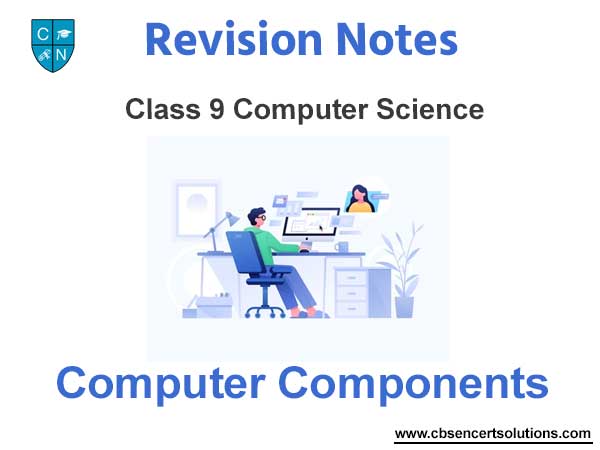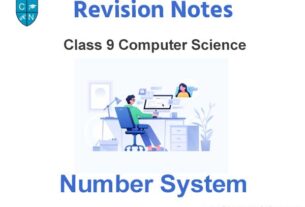Please refer to Computer Components Class 9 Computer Science notes and questions with solutions below. These revision notes and important examination questions have been prepared based on the latest Computer Science books for Class 9. You can go through the questions and solutions below which will help you to get better marks in your examinations.
Class 9 Computer Science Computer Components Notes and Questions
Question: What is the difference between computer hardware and software?
Answer: Computer Hardware:
Physical parts of the computer system that you can feel and touch are known as computer hardware. Examples: keyboard, mouse, motherboard, RAM, CPU etc.
Components of computer hardware:
Following are the components of computer hardware.
Input Unit: input unit consists of input devices. It is used to insert data into the computer. Keyboard, scanner, microphone are the major input devices.
Output Unit: output unit of computer system consists of output devices. It is used to display data from the computer. Printer, monitor and speaker are the major output devices.
System Unit: system unit contains number of other component which is enclosed in a rectangular casing. Casing is available in two forms, tower casing and desktop casing. Most important components of the system unit is motherboard. All other components are attached onto it.
Computer Software: Organized collection of computer data and instructions is called computer software.
Question: What is computer, computer program?
Answer: Computer:
Computer is an electronic device which is used to process data and give output in the form of information.
Computer Program:
Set of instructions given to the computer to solve a specific problem.
Question: Write short note on following
1. Central processing Unit
2. Arithmetic and Logic Unit
3. Control Unit
Answer: 1. CPU: CPU is a highly complex set of electronic circuitry that executes program instructions.
CPU has the ability to recall numbers from memory and perform arithmetic and logical operation with them such as addition or multiplication and then store the results.
2. Arithmetic and Logic Unit:
Part of the CPU which executes all arithmetic and logical operations is called ALU.
ALU can perform following operations
Addition
Subtraction
Multiplication
Division and
Logical operations
3. Control Unit:
Part of the CPU which directs the entire computer system to carry out or execute the programs is called CU.
It controls flow of information and helps to perform activities of other units. This job is performed through clock pluses. Clock pulses regulate the activities.
CPU has location to store the results which are still in process. These temporary storage locations of CPU are called registers.
Question: What are the logical operators?
Answer: Logical Operators:
The logical operators compare Boolean expressions and return a Boolean result.
Logical operators are
Equal: it is used for comparing two values either equal or not? The symbol used for this operator is “=”
Less equal: it return true when one value is less than second value. The symbol used for this operator is “<=”
Greater Equal: it returns true when first value is greater than the 2nd value. The symbol used for this operator is “>=”
Question: What are the CPU registers:
Answer: CPU has location to store the results which are still in process. These temporary storage locations of CPU are called registers.
Question: What is a system bus? Differentiate between data bus, address bus and control bus?
System Bus:
Answer: A communication channel through which devices a connected together is called a BUS or system bus. Data bus, address and control bus are collectively called as system bus.

Question: Differentiate between system software and application software?
Answer:

Question: Write a Note on Main Memory and secondary memory. Also give examples.
Answer: Main Memory:
- The memory which is directly accessible by the by the processing unit is called main memory.
- Contents are lost when computer is switched off.
- Store and retrieval of data is much faster from main memory.
- Main memory is located on mother board so data retrieval is faster.
- Main memory is expensive than secondary memory.
Examples: the example of main memory is RAM
Secondary Memory:
The additional memory to store data which is more than the storage of main memory is called secondary memory.
Examples: the example of secondary memory is flash memory, tape drives, hard disk drives, floppy disks etc.
Question: What are the different kinds of input devices and output devices?
Answer: Input Devices: the devices which are used to enter data and instructions into the computer are called input devices.
Kinds of Input Devices:
Keyboard
Pointing Devices
Mouse
Joy Stick
Scanning Devices
Scanner Voice
Input Devices
Microphone
Output Devices: The devices which are used to receive data and information from the computer are called output devices.
Kinds of Output Devices:
Most commonly output devices are:
Monitor
Printer
Speaker
Question: Define magnetic disk?
Answer: Magnetic Disk:
A memory device that is covered with a magnetic coating on which digital information is stored in the form of microscopically small, magnetized needles is called as magnetic disk.
Data on magnetic disk is recorded into the magnetic material in machine code. Disks have become popular due to their random access. These disk spin in the disk drives Read/Write heads moving on the disk along its radius can read data at any location under the heads.
Different types of disk drives and magnetic disks are in use. The most popular types of magnetic disks are interchangeable disks called the floppy disks and fixed disks called the hard disks.
Generally PCs are configured with at least one hard disk drive and one floppy disk drive. Hard Disk provided a very big storage capacity and are very fast but these are not inter changeable. Floppy disks are smaller than the hard disk, because they always consists only one platter. Floppies are available in size of 3.5″ and 5.25″ inches. Both of them are available in double density and high-density storage capacities. The storage capacities of these diskettes used for IBM compatible computer.
Question: Explain Random Access Memory.
Answer: Random Access Memory:
RAM is an example of main memory. The contents loaded in main memory are directly accessible by the CPU. It is also called a volatile memory because the contents are lost as the computer is switched off. Data storage and retrieval from RAM is much faster than secondary storage because it is present of motherboard.
Question: What is USB port?
Answer: A USB flash drive is a data storage device that consists of flash memory with Universal Serial Bus (USB) interface. USB flash drives are typically removable and rewritable, and physically much smaller than a floppy disk.
- Short for Universal Serial Bus,
- It supports data transfer rates of 12 Mbps.
- A single USB port can be used to connect up to 127peripheral devices.
- USB also supports Plug-and-Play installation and hot plugging.
Question: What is port? Also explain the difference between serial and parallel port.
Answer: Port:
An interface on a computer to which you can connect a device is called a port.
Personal computers have various types of ports. Internally, there are several ports for connecting disk drives, display screens, and keyboards. Externally, personal computers have ports for connecting modems, printers, mice, and other peripheral devices.
Almost all personal computers come with a serial RS-232C port for connecting a modem or mouse and a parallel port for connecting a printer.
Difference between Serial and Parallel port:

Question: What is floppy disk? Differentiate between hard disk and floppy disk:
Answer: Although slower than a hard disk, are inexpensive and can easily moved from computer to computer. They are comparatively fragile and must be handled with care.
Difference in the Capacity between Hard Disk and Floppy Disk
A hard disk contains several disk platters stacked on a single rotating spindle. Data are stored on all recording surfaces. For a disk with four platters, there are eight recording surfaces on which data can be stored. A floppy disk has only one platter on which data is written, that is why the storage capacity of a hard disk is more as compared to the floppy disk. Hard disks or fixed disks are also called Winchester disk are permanently installed or fixed within the system unit.
Data Processing
Data processing often referred as D.P is a process of collecting the data together and converting the data into information. The method used for collecting the data may be manual, mechanical or electronic.
Data processing is a term mostly associated with business and commercial work. Since computers are being used in the processing of data the term “electronic data processing” may also be used.
Electronic Data Processing
Data processing means transformation of data into more meaningful results for carrying out scientific, business activities. The result of data processing is called “information”. The transformation of data consist of a sequence of operations. The sequence is called “procedure”.
Input -> Processing -> Output
Data processing is a system which takes data as an input, carries out the required processing on the data and produces the information. The system is called “MANUAL” when processing is performed by human bein gs and “AUTOMATIC” when machines are used. When computers are used for data processing the system is called “Electronic Data Processing”.
Elements of EDP
There are five basic elements in a processing system which uses a computer for processing data. These are hardware, software, user program, procedure and personnel.
- HARDWARE
All the physical parts which makes up a computer system called hardware i.e. all the devices or peripherals which performs the data processing operations. - SOFTWARE
Software consists of programs and routines whose purpose is to make the computer useable for the user. These software normally supplied by computer manufacturers or software manufacturers. - USER PROGRAM
A program consist of a related instructions to perform operations. A data processing job may require a number of programs. - PROCEDURE
The operations of data processing system requires procedure for use, in preparing data, for operating the computer and distributing the output after processing. - PERSONNELS
E.D.P basically needs three kinds of skilled personnels.
a) System Analyst
b) Progammer
c) Operator
a) SYSTEM ANALYST
System Analyst studies information needs and data processing requirements, design a data processing system and prepare specification.
b) PROGRAMMER
A Programmer writes a programmer on specification by System Analyst.
c) OPERATOR
An Operator is a person who operates the computer system.


